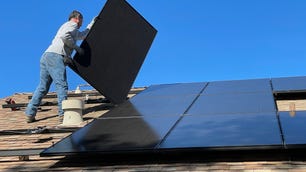How much does a Tesla Powerwall cost?


The powerful Tesla Powerwall battery is benefiting from the brand’s broad recognition in the automotive sector and a surge in residential solar adoption. This increase has been further fueled by incentives including a federal tax credit This allows you to declare 30% of the total cost of your storage system on your tax return.
Tesla itself has recently started offering discounts that can be combined with other discounts.
But even with the many discounts, rebates and other benefits, batteries are often the most expensive part of a residential solar system.
Fortunately, the Powerwall 3 is significantly cheaper than the Powerwall 2, with the newer model retailing for around $6,000 in various locations across the US. The incentives make it an even better deal — it’s arguably the most affordable battery available today.
In this short guide, we’ll take a closer look at the Tesla Powerwall 3 so you can decide whether it’s worth purchasing.
According to Garrett Mendelsohn, founder of Solar bootcamp.
“The thing about batteries is they have a lifespan of 10 to 15 years, and often homeowners will finance for 25 years,” he says. “So you’re financing a product that at the end of 25 years is essentially going to do nothing and you’re paying interest on it.”
Let’s dig into the details so you can judge what makes sense for you.
What is the Tesla Powerwall?
Simply put, the Tesla Powerwall is a large battery that can be mounted inside or outside your home. It can be connected to charge an electric vehicle in your garage, provide backup power, store excess solar power from a connected solar array, or all of the above. You can also connect multiple Powerwalls together for more capacity to do all of these things at once.
A Tesla Powerwall solar battery, like any other solar energy storage system, can keep your essential systems online during power outages, help you maximize your net metering savings, or even be your primary energy source if you have an off-grid installation.
The Powerwall 3 is the latest model, offering a major upgrade over previous versions while being much more affordable. However, it is not compatible with older Powerwall systems.
Those are the basics. Here are some of the more technical details:
Tesla Powerwall Battery Specifications
| Category | Tesla Powerwall 2 | Tesla Powerwall Plus | Tesla Powerwall 3 |
|---|---|---|---|
| Usable capacity | 13.5 kWh | 13.5 kWh | 13.5 kWh |
| How much can I stack? | Up to 10 units | Up to 10 units | Up to four units |
| Return efficiency | 90% | 90% | 89% |
| Depth of discharge | 100% | 100% | 100% |
| Continuous power output (on the grid) | 5 kW | 5 kW | 11.5 kW |
| Continuous power delivery (off-grid) | n/a | 7 kW – 9.6 kW | n/a |
| Battery type | Lithium-ion | Lithium-ion | Lithium-ion |
| AC or DC coupled? | Alternating current | Alternating current | Alternating current |
| Price | $8,400 – $13,000 | $8,400 – $13,000 | ~$6,000 |
How much does a Tesla Powerwall cost?
Adding energy storage to your home can be a big investment. The Tesla Powerwall 3 typically costs around $6,000 before taxes and installation. If that price seems steep for a single battery, consider that Powerwalls used to cost between $8,400 and $13,000. And that price is miles ahead of other comparable storage systems on the market.
Other factors can impact the total cost of installing a Powerwall, such as labor and material costs to place it in a safe and convenient location. On the other side of the ledger, federal tax credits, other incentives from state and local governments, utilities, and even Tesla itself can help bring the net price down.
Tesla offers a energy design tool to boost sales, but it’s also helpful to get an idea of how much you can expect to spend on a home solar system with a Tesla Powerwall battery. Depending on your home’s energy needs, you may need multiple Powerwalls if you want to create a whole-home backup.
And remember, don’t make important decisions based on online research alone. Talk to multiple installers in your area to get more than one quote that’s specific to your situation.
Pros and cons of the Tesla Powerwall
Advantages:
- Unlimited cycle guarantee
- High power
- All-round efficiency and performance
- Cheaper than other batteries of similar size
- Compatible with and without solar panels
Disadvantages:
- Limited modularity
- Energy management app that is stuttering
- Bad reputation for customer service
- Not compatible with other Powerwall models
Tesla Powerwall 3 vs. Other Batteries
| Category | Tesla Powerwall 3 | Generac Pwrcell | LGES 16H Prime | Enphase IQ Battery 10/10T | SunPower SunVault |
|---|---|---|---|---|---|
| Usable capacity | 13.5 kWh | 9 kWh – 18 kWh | 16 kWh | 10.08 kWh | 13 kWh – 39 kWh |
| How much can I stack? | Up to 10 | Maximum two battery cabinets | Up to two | n/a | Up to two |
| Return efficiency | 90% | 96.50% | >90% | 89% | 86% |
| Depth of discharge | 100% | 84% | 100% | 98% | 92% |
| Peak power (mains current) | 30 kW | 4.5 kW – 9 kW | 11 kW | 5.7 kW | 10 kW – 12 kW (off-grid) |
| Continuous power output (to the grid) | 11.5 kW | 3.4 kW – 7.6 kW | 7 kW | 3.84 kW | 6.8 kW – 13.6 kW (off-grid) |
| AC or DC coupled? | Alternating current | direct current | direct current | Alternating current | Alternating current |
| Price | ~$6,000 | $10,000 – $20,000 | $7,000 – $11,000 | $8,000 – $10,000 | $16,000 – $26,000 |
Is the Tesla Powerwall Worth It?
If you’re looking to store a significant amount of energy for your home, the Powerwall is a solid choice. It has a great warranty, strong performance, an extremely competitive price, and the backing of a well-known brand. But some have reported that the company’s customer service has been lacking. Tesla no longer has a media office and declined to comment for this story.
For those who already have a Powerwall 2 or Powerwall Plus model, you should know that You cannot install the Powerwall 3 within your existing system. That could be a dealbreaker, of course. But it’s clear that Tesla wants you to step up to the Powerwall 3 and leave the older, less powerful models behind. Since one of these is much more powerful than previous models, it could be a smart upgrade.
If you’re on the fence about buying a big battery, Mendelsohn advises that it might be better to wait. Most home solar system components come with a 25-year warranty, but batteries rarely last more than a decade, he points out.
“If you don’t have blackouts, it’s not really worth it for the price. You’re spending $13,000 to $15,000 … for a battery that can’t even do the whole house,” Mendelsohn says. “So it doesn’t really make much sense until battery technology gets better and they can get a 25-year warranty.”
Frequently Asked Questions
Does the Tesla Powerwall qualify for the federal solar tax credit?
Yes, a Powerwall qualifies for a 30% federal tax deduction.
How many Tesla Powerwalls do I need?
There are several factors at play here, including your energy goals and the needs of your home. You can get an idea by using Tesla’s energy design tool and talking to local installers.
What is the difference between the Tesla Powerwall Plus, Powerwall Plus, and Powerwall 3?
The Tesla Powerwall 2, Plus, and 3 all have a usable capacity of 13.5 kWh and a 100% depth of discharge, but differ in power and integration. The Powerwall 2 has a continuous output of 5 kW, while the Powerwall Plus adds a built-in solar inverter and increases backup power to 9.6 kW in full sun. The Powerwall 3 is the most powerful, offering 11.5 kW continuous output, but is not backwards compatible, limiting modularity to four units. All models share an unlimited cycle warranty, but the performance of the Powerwall 3 is a significant upgrade.





